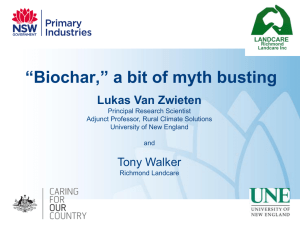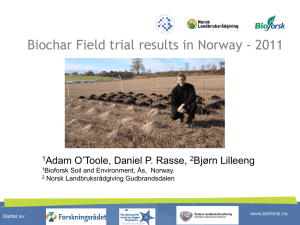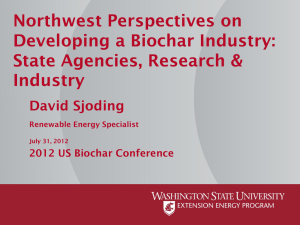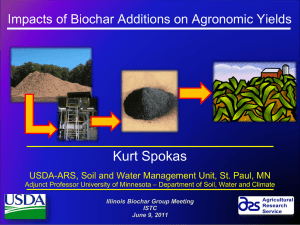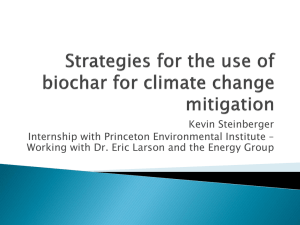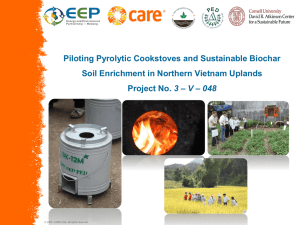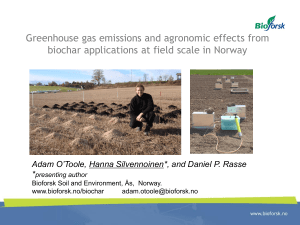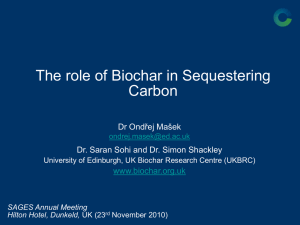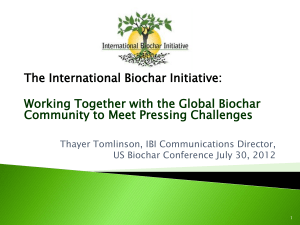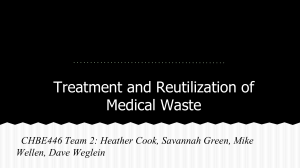Presentation File - 2012 US Biochar Conference
advertisement
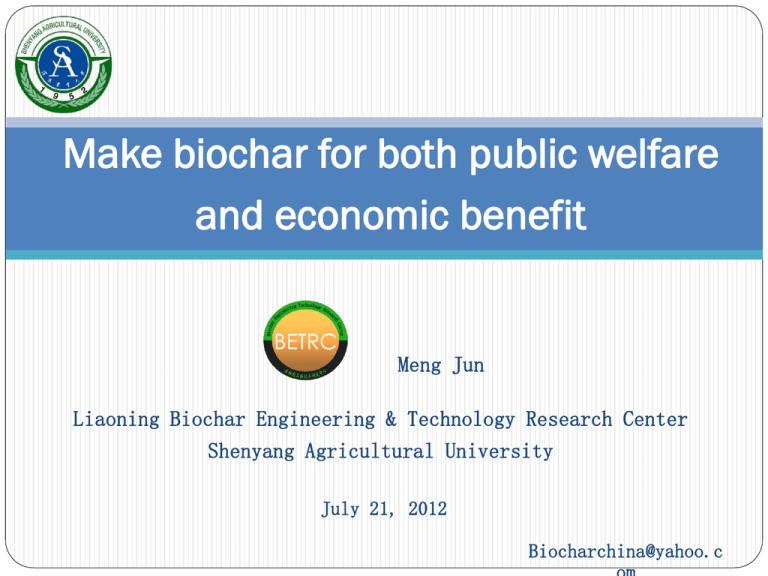
Make biochar for both public welfare and economic benefit Meng Jun Liaoning Biochar Engineering & Technology Research Center Shenyang Agricultural University July 21, 2012 Biocharchina@yahoo.c Liaoning Biochar Engineering & Technology Research Center The first provincial research institution for biochar in China. Leading by Prof. Chen Wenfu of Shenyang Agricultural University, the academician of Chinese Academy of Engineering, BETRC endeavored into the biochar research. After years of practices, "carbonization and returning" strategy for agro-forestry residue utilization, which based on in situ biochar production equipment and biochar based products, was refined gradually. 1 Public concern food security is still a great issue to be concerned in near future 0.5 billion tons of food production ability maintained for nearly 8 years. Population scored 1.3379 billion and still increase. 1.38 mu or 0.092 ha cultivated land per capita, 40% of world’s average. China is a middle dangerous food security country. Cited from: http://documents.wfp.org/stellent/groups/public/ documents/communications/wfp229328.pdf Limited crop land suffered sever erosion •1.826 billion mu or 0.12 billion ha crop land which still decreasing. •70% of which is low yielding farmland at the end of 2009. (Ministry of Agriculture) •Heavy metal contamination: According to the Ministry of Agriculture, 46.7% of 2.1 million mu arable land irrigated by waste water was slightly contaminated by heavy metals, 9.7% was moderate contaminated, and 8.4% was severely contaminated. •Erosion of black soil: In Heilongjiang 100cm to 20~40cm, and still disappeared at 3~ 3.5mm annually. In Jilin province, 12% of black soil layer is thinner than 20cm, among which, 3% acreage totally lost it. •Dramatically acidify of red soil: 0.42 Agricultural field area (0.1 billion mu) province, black soil layer decreased from 60~ billion mu red soil, which pH bellow 4.5, even 2.6, caused dramatically nutrition deficient. Cited from: 2008 Bulletin of land and resources of China Huge amount of agricultural residues 700 million tones of agricultural residues. Quantities of cereal straw, fungi matrix, peanut hull and rice husk. Straw returning to soil might be a good choice, but not easily carried out, especially in northern China which restricted by low temperature. Significant environment pollution is the inevitable result of lacking of effective comprehensive utilization method. Current situation and questions put forward The current situation is: quantities of biomass residues, which should be considered as precious resources, are disposed or burned, and causes unaffordable ecological issues and notable soil degradation. How to get those biomass, what we get from the soil, go back to the soil, might be a great challenge we have to face to. soil biomass In spite of great efforts on straw returning, only 15 percent of those residues could be returned to the soil. 2 Biochar might be a good candidate, but how to make it work practically ? •Advantages of biochar: •Porous structure to shield microorganism. •Alkalinity to ameliorate acidified soil. •Stability and high carbon content. •Available potassium. •Good absorption ability. Porous structure of biochar •Farmers won’t pay for biochar because of additional input, neither labor nor money. •Government may provide public subsidies but can not cover all over the country. •Farmer and government left the major role to enterprise. Enterprise: improve added value or lower the cost Improving the added value means additional input in crop production in most cases, and might not work if farmers have to pay for it. The only way left is lower the cost of biochar production and application in relatively near future. So, the centralized production mode which increases transportation cost should be revised, and the labor saving application method should win its priority, especially in China. Long distance transport of biomass Biochar for garden use, $29.95/10L Step 1: Cost effective biochar production is the basis for utilization of agricultural residues at large scale Traditional kiln Semi-hermetic kiln cost effective Modular kiln Traditional biochar production mode of •Small scale biomass collection, transport and centralized •Energy saving or energy free carbonization was transferred into a new one: •Mobility carbonization in situ, collect and transport •Environmental friendly biochar for down-stream processing. Step 2: Biochar based fertilizer/products facilitate the incorporation of biochar into soil Biochar based fertilizer Biochar based soil amendment • Increase fertilizer utilization ratio • Cut off chemical input and decrease environmental pollution Nutrients in the pores of biochar • CO2 emission reduction • Water retention Combination of biochar and nutrients Experimentation, demonstration and extension Cooperating with peanut and potato industry system, more than 20 field trail stations were included in experimentation and demonstration, 20 provinces were involved. BETRC Plot experiments Demonstration sites in Liaoning province Demonstration sites in China Returning of rice straw biochar Biochar based potato fertilizer Application of biochar based peanut fertilizer Biochar granum remain in the soil Research basis Surface scan of biochar Microorganism analysis Root in biochar Neighbour-joining phylogenetic tree of bacteria based on the genetic distance Research expansions Biochar serve as seed bed matrix of rice and tobacco Application of biochar in acidified black soil, sandy soil and saline-alkali soil Biochar ameliorated rice field Step 3: A distributed biochar network Produce biochar based fertilizer 100,000 ton; Cover agricultural field 130,000 ha; Need biochar 30,000 ton; Consume biomass 100,000 ton, equals to quantities from 22,000 ha of field; Field area=2826 ha No resource competition Utilization ratio=50% Air dried biomass per ha=4.5 ton Total air dried biomass= 6359 ton Produce biochar=1908 ton 3 km Operating mode Farmer Reduce farmer labor cost Farmer Reduce transportation cost In situ biochar production Biochar cost about ¥300, equals to $47. I give you biochar, you give me biochar based fertilizer instead of currency! 3 News media take a real interest in biochar, which means the huge demand and market Reports from China Central Television (CCTV) and Liaoning provincial media about our work. CCTV reports titled by “Charring before sowing” Introduce biochar for news agency 4 Multiple economic and social benefits No crop competition, no arable land competition. Come from agriculture, go back to agriculture. Hand grab for new countryside construction. We are seeking for a better answer! We can not get more arable land, but we can make it better! We are BETRC Thanks for your attention! Your advices will be helpful!
